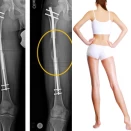
Limb Lengthening Surgery Side Effects
- Limb Lengthening Surgery Side Effects
Limb lengthening surgery, like any surgical procedure, carries potential risks and side effects. It's important to be aware of these potential complications before considering the surgery. Here are some possible side effects and risks associated with limb lengthening surgery:
Infection: Surgical procedures carry a risk of infection. Despite strict protocols and preventive measures, there is still a possibility of infection at the surgical site, which may require additional treatment, such as antibiotics or further medical intervention.
Soft tissue complications: During the lengthening process, the surrounding soft tissues, such as muscles, tendons, and ligaments, may experience stress and tension. This can lead to issues such as muscle weakness, joint stiffness, or contractures, which may require additional physical therapy or rehabilitation.
Nerve or blood vessel injury: While rare, there is a risk of damage to nerves or blood vessels during the surgical procedure or during the adjustment of external fixators. Nerve or blood vessel injuries can result in sensory changes, numbness, or decreased circulation in the affected limb.
Joint problems: Lengthening the bones can put stress on the joints, potentially leading to joint stiffness, limited range of motion, or even arthritis in the long term. Proper post-operative rehabilitation and physical therapy are crucial to minimize these risks.
Psychological challenges: Limb lengthening surgery requires a significant commitment and a prolonged recovery period, which can cause psychological challenges. Patients may experience frustration, emotional distress, or difficulty adjusting to temporary mobility limitations or lifestyle changes during the lengthening process.
Scarring: Surgical incisions can result in visible scars. The size and visibility of scars can vary depending on surgical techniques and individual healing responses.
Lengthening discrepancy: Achieving perfect symmetry in limb lengthening can be challenging. Despite careful planning and execution, a slight discrepancy in limb lengths may remain after the surgery.
It's important to note that while these risks and side effects exist, they do not affect every patient who undergoes limb lengthening surgery. Skilled surgeons, comprehensive pre-operative evaluations, adherence to post-operative care instructions, and proper rehabilitation can help minimize these risks and optimize outcomes. It is essential to consult with a qualified orthopedic surgeon who can assess your specific situation and provide personalized advice.

Limb Lengthening Surgery Price
The cost of limb lengthening surgery can vary significantly depending on various factors, including the country or region where the surgery is performed, the specific surgical technique used, the complexity of the case, the surgeon's expertise, the hospital or clinic chosen, and additional costs such as pre-operative evaluations, post-operative care, and rehabilitation.
It is challenging to provide an exact price without specific details, but limb lengthening surgery is generally considered a complex and expensive procedure. In some cases, the cost can range from tens of thousands to hundreds of thousands of dollars. It's important to keep in mind that these costs typically cover the surgical procedure itself, hospital or clinic fees, anesthesia, medical supplies, and post-operative care.
Additionally, it's crucial to consider potential additional expenses such as travel costs, accommodations, pre-operative evaluations, physical therapy or rehabilitation sessions, and any unforeseen complications that may require further medical attention.
If you are considering limb lengthening surgery, it is recommended to consult with a qualified orthopedic surgeon or medical professional who specializes in limb lengthening procedures. They can provide you with a detailed assessment of your specific case and discuss the associated costs and financial considerations. It's also advisable to inquire with your insurance provider to determine if any portion of the procedure may be covered by your insurance policy, although coverage for elective procedures like limb lengthening surgery may vary.
Ultimately, the cost of limb lengthening surgery should be carefully evaluated alongside other factors such as potential risks, benefits, recovery period, and individual goals before making a decision.
Height Lengthening Surgery: An Overview of the Procedure and Considerations
Introduction: Height lengthening surgery, also known as stature lengthening or limb elongation surgery, is a specialized surgical procedure aimed at increasing a person's height. This innovative technique offers a potential solution for individuals who desire to gain height beyond their natural growth potential. Height lengthening surgery involves the gradual lengthening of the long bones in the legs, resulting in an overall increase in stature.

Evaluation and Candidate Selection:
- Initial consultation: Individuals considering height lengthening surgery undergo a comprehensive evaluation by an orthopedic surgeon. Factors such as overall health, skeletal maturity, realistic expectations, and psychological readiness are assessed.
- Medical imaging: X-rays, CT scans, or MRI scans are used to evaluate bone density, alignment, and determine the feasibility of the procedure.
- Psychological assessment: Since the procedure requires a significant commitment, candidates undergo a psychological evaluation to ensure they have a clear understanding of the process and realistic expectations.
The Height Lengthening Procedure: a. Surgical approach: The surgery is typically performed under general anesthesia. The surgeon makes small incisions in the leg bones to access the bone marrow and prepare for the lengthening process. b.
External or internal fixation: External fixators or internal nails are used to stabilize the bone segments during the lengthening phase. External fixators are often preferred due to their adjustability and ability to control the rate of bone lengthening. c.
Bone distraction and lengthening: After surgery, a gradual distraction process begins. Patients or their caregivers adjust the external fixator daily, causing controlled separation of bone segments. This stimulates new bone formation within the gap, gradually lengthening the bone. d.
Consolidation and healing: Once the desired height is achieved, a consolidation phase follows, allowing the newly formed bone to solidify and strengthen. The external fixator may remain in place during this period to provide stability.
Recovery and Rehabilitation:
- Post-operative care: Pain management, wound care, and proper weight-bearing instructions are provided to optimize healing and reduce complications.
- Physical therapy: A customized rehabilitation program focuses on strengthening muscles, improving range of motion, and enhancing gait mechanics.
- Follow-up and monitoring: Regular follow-up visits with the medical team are essential to monitor progress, adjust the external fixator if necessary, and address any concerns.
Potential Risks and Considerations:
- Infection and soft tissue complications
- Nerve or blood vessel injury
- Joint stiffness and muscle weakness
- Psychological and emotional challenges during the lengthy recovery period
Realistic Expectations and Lifestyle Adjustments:
- Candidates must have realistic expectations regarding the achievable height increase and understand that the process requires time, commitment, and a comprehensive rehabilitation plan.
- Lifestyle adjustments, such as temporary mobility limitations and the need for assistive devices, should be considered during the lengthening and recovery period.
Conclusion: Height lengthening surgery offers individuals an opportunity to achieve an increase in height beyond their natural growth potential. However, it is important to undergo thorough evaluation, consider potential risks and complications, and have realistic expectations. By working closely with a skilled medical team, following the recommended rehabilitation plan, and understanding the commitment involved, individuals can navigate the height lengthening journey and potentially achieve their desired increase in stature.





